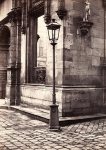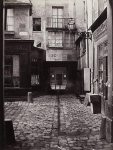In the 1850s and 1860s, the city of Paris went through an unprecedented transformation. At the behest of Baron Haussmann, urban planner to the Emperor Napoleon III, its ancient maze of narrow streets was systematically torn down to make way for the grand boulevards that define the cityscape today. The task of documenting the city in transition fell to Charles Marville, the subject of a show at the Metropolitan Museum of Art entitled ‘Marville: Photographer of Paris.’
Impasse de la Bouteille from the rue Montorgeuil (Second Arrondissement) (1865–8), Charles Marville. © Musée Carnavalet / Roger-Viollet
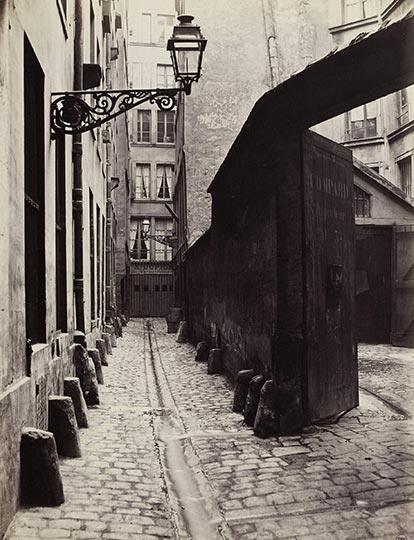
After the first major show of his work in 1980, Marville’s status as a premier urban archivist was cemented, fostered by the burgeoning post-modern fascination with the archive as genre. The majority of Marville’s work was indeed commissioned for the city of Paris during the period of ‘Hausmannisation,’ and Marville-as-archivist is on ample display at the Met. Many of his photographs are well-composed documents of the detritus of 19th-century Paris: urinals, lampposts, and unremarkable street corners plastered in period advertisement, interesting largely as historical testimony of a time inaccessible to us captured in a medium that is disarmingly familiar.
- ‘Hôtel de la Marine’ (1864–70), Charles Marville.
- ‘Arts et Métiers (Ancien Modèle)’ (1864), Charles Marville.
- ‘Lamppost, Entrance to the École des Beaux-Arts’ (c. 1870), Charles Marville.
Yet while the lure of the archive is part of Marville’s charm, a far more complex photographer emerges in the Met’s superbly curated show. Marville began his career as an illustrator, and it becomes clear that he was at heart a landscape photographer, a practitioner of a kind of domesticated Romanticism heavily influenced by French 18th-century landscape painting and yet also anticipatory of Impressionism. Nowhere is this remarkable eye more apparent than in his portrait of a man (possibly himself) reclining under a chestnut tree, in which the foliage, the figure, and the play of light and shade form a perfectly composed and entrancing whole without any hint of sentimentality.
Marville uses his camera to summon glimpses of Romantic landscapes throughout the city: in the suburbs just being annexed into the city; in the gardens of the École des beaux-arts; in a scene of Paris under the snow; in his superb photographs of the Bois de Bologne, and above all in the series of cloud studies he took above the Parisian rooftops.
Of his scenes of the natural world, only these last remarkable photographs of light and air gesture toward a wilder, more sublime Romanticism. Strange though it might seem, however, it is precisely the aesthetics of the sublime, informed by a keen historical consciousness, that determine Marville’s engagement with the urban landscape of the city. Over the course of the 19th century, Paris was the scene of multiple failed revolutions, culminating with the Paris Commune of 1871 in which swaths of the city were destroyed. If Haussman’s levelling of Paris was all for the inexorable progress of modernity, the destruction of Paris during the Commune was a futile historical tragedy.
Rue de Constantine (Fourth Arrondissement) (1866), Charles Marville. The Metropolitan Museum of Art,
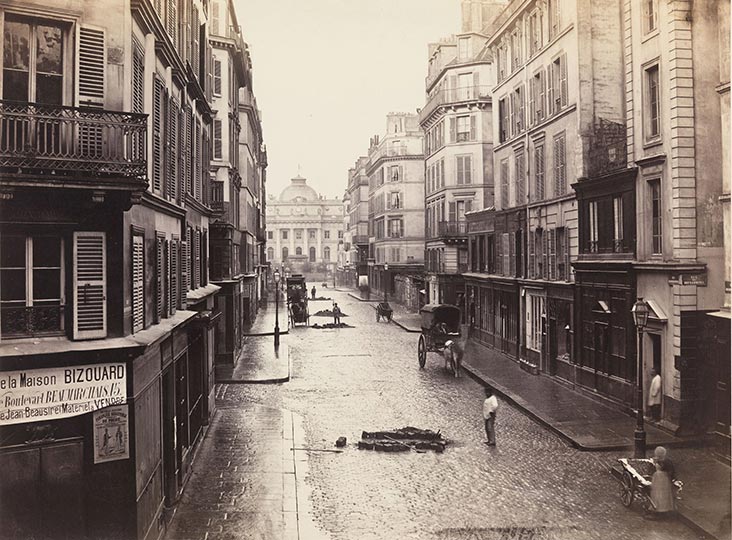
In Marville’s ‘Percement de l’Opéra’ series, which depicts the demolition required for the new boulevards, the futile and the progressive forces of change are confused. Piles of debris litter the foreground of the photographs. Workers chip away at half-deconstructed walls to which peeling wallpaper and other disconcerting signs of the displaced former occupants still cling. The figures of the workmen on the piles of rubble recall the street barricades of all of the revolutions that had ravaged Paris over the course of the century.
Hausmann’s wide avenues were designed precisely to bring about the end of revolutionary turmoil by making the streets too wide to barricade, but in Marville’s photographs, the glorious and ordered future of the boulevards is nowhere in sight. Instead, Haussmann’s project is just another of the many violent upheavals in the cityscape, one that may have no more salutary consequences than any of the others.
Top of the rue Champlain, View to the Right (Twentieth Arrondissement) (1877–8), Charles Marville. © Musée Carnavalet / Roger-Viollet
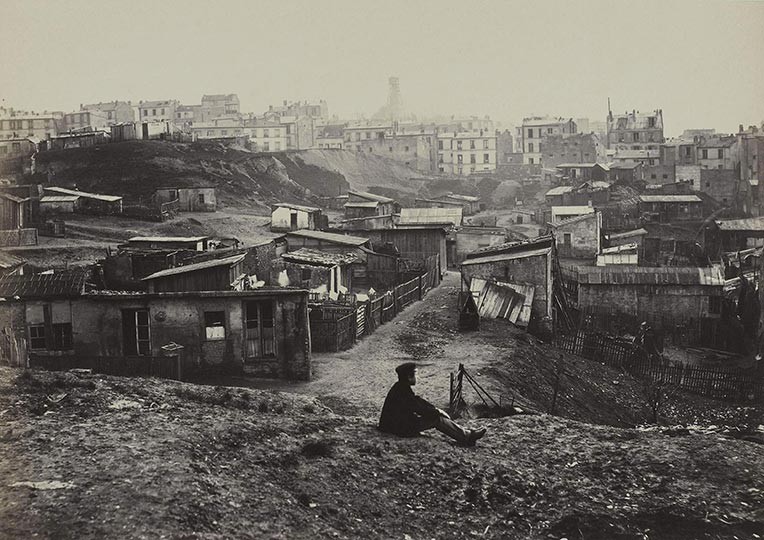
It is in these skeptical photographs of the city’s violent disembowelment that the force of Marville’s unique Romantic eye is revealed. His is a different geography of the sublime. Gone are the jagged valleys and wild streams of Mont Blanc; instead, the sublime has been transposed onto the city of Paris itself. Insignificant humans, working to an unknown and dubious end, subject to political and historical forces beyond their control, are juxtaposed against two landscapes equally vast and incomprehensible: the city that they are attempting to take apart, and the city that they are being compelled to create in its place.
- ‘Passage Saint-Benoît (Sixth Arrondissement)’ (1864–7), Charles Marville.
- ‘Rue Estienne from the rue Boucher (First Arrondissement)’ (1862–5), Charles Marville.
Marville’s sublime is all the more cruel for its transposition into the populated space of the city, but its aesthetic power is undiminished. In his seemingly documentary photographs, Marville accomplishes an incredible feat of double vision, capturing the beauty in that which is most terrifyingly and sublimely modern – the dehumanising city, the incomprehensible progress of history, the violence of war – without justifying or sentimentalising the historical reality underpinning that aesthetic experience. He is no simple photographer of the city of Paris, but an artist of the modern experience.
‘Charles Marville: Photographer of Paris’ is at the Metropolitan Museum, New York, until 4 May.



